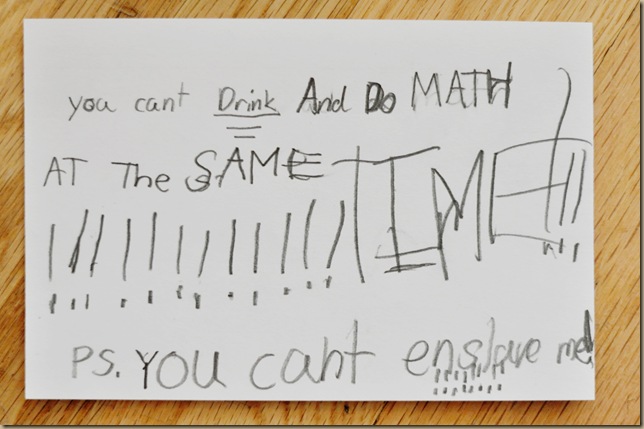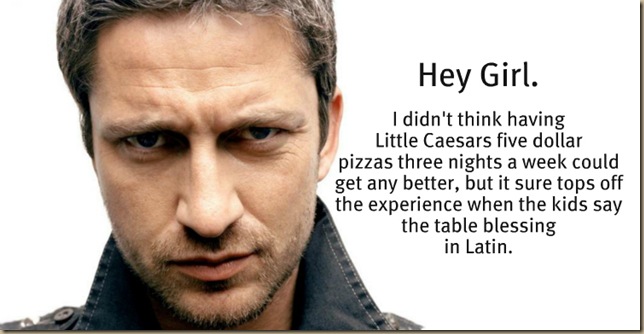Breathe in {Truth}, Breathe out {Grace}
:: From Beauty for Truth's Sake: On the Re-enchantment of Education by Stratford Caldecott (much more where this came from, but that will have to be a post in itself…):
No wonder students come to a college education expecting nothing more than a set of paper qualifications that will enable them to earn a decent salary. The idea that they might be there to grow as human beings, to be inducted into an ancient culture, to become somehow more than they are already, is alien to them. They expect instant answers, but they have no deep questions...The process of education requires us to become open, receptive, curious, and humble in the face of what we do not know. The world is a fabric woven of mysteries, and a mystery is a provocation to our humanity that cannot be dissolved by googling a few more bits of information.
:: Why Homeschooling is a Boon to a Liberal Society @ The Atlantic:
There is value in the public education system. Lots of intelligent, informed people have helped to shape its curriculum and norms. Consider their model with an open mind, and depart from it only after taking their claims seriously. And if you reach an informed conclusion that a different model is better, if that is your strong conviction, go out and be the change you want to see in the world. It may happen that you're right or wrong, but society as a whole requires people who challenge the prevailing system if it is to identify the few who can offer new insights.
:: Perspectives on Raising Servants (Part 1): The Service of Leadership by Tucker Teague @ Classical Conversations:
Many of our popular stories are of individuals faced with the call to leadership and their struggle to accept that responsibility. It is our nature to seek and need leaders. What we often fail to see is that true leadership is, fundamentally, about service and sacrifice, not about position, power, or even education. In other words, true leaders are something other than mere figureheads or those giving commands. One does not need to command armies to be a leader, but one cannot be a leader without first being a servant.
:: CiRCE Institute FB status:
From the apprenticeship: 5 faculties the successful teacher cultivates: 1. Attentive perception 2. Recollection (the ability to go into your mind and get what you are looking for) 3. Contemplation (the ability to compare) 4. Re-presentation (depends on skills cultivated without which a person cannot re-present the truth) 5. Imagination (that which fulfills the skills learned).
:: Parker J. Palmer on teaching well (HT: Mental multivitamin):
Good teachers possess a capacity for connectedness. They are able to weave a complex web of connections among themselves, their subjects, and their students so that students can learn to weave a world for themselves. The methods used by these weavers vary widely: Socratic dialogues, laboratory experiments, collaborative problem solving, creative chaos. The connections made by good teachers are not in their methods but in their hearts -- meaning heart in its ancient sense, as the place where intellect and emotion and spirit and will converge in the human self.
:: This is an excellent video of Andrew Kern (of CiRCE Institute) speaking on teaching literature. Some of my favorite take-aways:
‘Every single story by its nature is a morality tale. It is about someone who does something to overcome a problem. And the moral of the story is always contained in the ultimate final decision that the character makes to overcome that problem. So the question that opens up any story, whether it be a fable or James Joyce or Homer or whatever, the question to explore is, “Should he have done that?”’
Play with the frog, don’t pin it to the table.
Five topics of literature discussion:
What is that? What do you mean by that? What kind of thing is that? Topic of definition.
How is that similar? How is different? Topic of comparison.
What was happening at the time? (Topic of context?)
Is it probable? Is it possible? (If it’s not possible, should he try anyway?) Topic of relations. Cause and effect.
Topic of authority. Witnesses and judges. (First-hand accounts and experts.)
Two threats to homeschooling: moralizing and anxiety. Make homeschooling winsome not fearsome.
Teach from a state of rest.
:: Boy, howdy. That’s a challenge. But it brings to mind another quote from Beauty for Truth’s Sake (just this one last quote until I can do a full review post):
As we have seen, the “Liberal” Arts are precisely not “Servile” Arts that can be justified in terms of their immediate practical purpose. “The ‘liberality’ or ‘freedom’ of the Liberal Arts consist in their not being disposable for purposes, that they do not need to be legitimated by a social function, by being ‘work.’” …At the heart of any culture worthy of the name is not work but leisure, schole in Greek, a word that lies at the root of the English word “school.” At its highest, leisure is contemplation. It is an activity that is its own justification, the pure expression of what it is to be human. It is what we do. The “purpose” of the quadrivium was to prepare us to contemplate God in an ordered fashion, to take delight in the source of all truth, beauty, and goodness…"
:: Speaking again of Beauty for Truth’s Sake, did you listen to the conversation between Leigh Bortins and Andrew Kern that I linked last month? That interview left me hungry for more and ultimately led me to purchase the book by Stratford Caldecott, which was a delicious feast. My book is underlined and marked throughout. Both relate to the quadrivium: arithmetic (pure number), geometry (number in space), music (number in time), and astronomy (number in both space and time (or motion)), and then how those subjects reflect the nature of God. I don’t want to give away any more of the book as I will be reviewing it in a post of its own, but I did want to share a link to a second conversation between Leigh Bortins and James D. Nickel, author of Mathematics: Is God Silent? which addresses many of the same concepts.
:: Following the rabbit trail of the beauty of mathematics (there are three humorous, quirky videos in the series):
:: Okay, just for laughs, one more link @ The Risk of Education:
Lines from The Princess Bride that Double as Comments on Freshman Composition Papers
I know the links and quotes are a great deal to digest, and I’m not sure if anyone is interested in taking advantage of them, but it is handy to have a record of the information here for my own reference.
Classical Conversations (Cycle 3) Weeks 17-19 (One morning each week; includes social time and public speaking.)
Faith:
CC Memorizing John 1:1-7 (in Latin and English)
The Children’s Illustrated Bible (reading together)
Telling God's Story
(Luke: weekly hymns on piano)
Math:
Teaching Textbooks
The Critical Thinking Co. math workbooks
Khan Academy videos and practice
Math-Whizz (online math)
CC weekly memory work (skip counting/formulas/laws)
Science:
Christian Kids Explore Chemistry (Read lessons 7-12 with oral review)
CC weekly science memory work (chemistry)
CC weekly science projects and experiments
Borax crystals
P.E.:
Swim Team practices (Levi), Swim Lessons (Luke and Leif)
Fine Arts:
CC weekly famous artists and art projects
Monthly Fine Arts Study (O’Keeffe, Holst, William Carlos Williams)
A River of Words: The Story of William Carlos Williams by Jen Bryant
William Carlos Williams (documentary video on YouTube)
Georgia Rises: A Day in the Life of Georgia O’Keeffe by Kathryn Lasky
My Name is Georgia: A Portrait by Jeanette Winter
Georgia O’Keefffe: The “Wideness and Wonder” of Her World by Beverly Gherman (117 pp, Levi-IR)
Great Women Artists: Georgia O’Keeffe (DVD)
O'Keeffe's The Lawrence Tree, 1929 from Smarthistory Videos on Vimeo.
Piano practice and lessons (Luke)
Language Arts:
IEW Writing (Levi: Fables, Myths, and Fairy Tales Writing Lessons)
MCT Caesar’s English (vocabulary)
MCT Practice Town (4 level sentence analysis + diagramming)
MCT Paragraph Town (finished reading through)
Writing With Ease (Luke and Levi)
CC grammar memory work
All About Spelling Level 2 (finished!) and Level 3 (began)
Handwriting Without Tears workbook (cursive-Levi)
Geography:
CC U.S. geography (states, capitals, mountains, rivers, lakes, features, and more)
Geography games (capitals, states, landscapes)
Place the State online game
Map drawing and 'blobbing' continents (CC)
The Scrambled States of America by Laurie Keller
History/Literature/Historical Fiction:
The Story of the World: Early Modern Times (chapters 29-37)
CC weekly history memory work (American history)
The Usborne Encyclopedia of World History (select pages, Luke)
The Kingfisher History Encyclopedia (select pages, Levi)
DK Children's Encyclopedia of American History (select pages)
The American Story: 100 True Tales from American History by Jennifer Armstrong
(Oliver Twist, North & South, DVDs, historical fiction, industrial revolution in England)
Midnight Is a Place by Joan Aiken (historical fiction, industrial revolution in England, 287 pp, Levi-IR)
The Bobbin Girl by Emily Arnold McCully (based on memoirs of a real mill girl of the 1830s)
The Trailblazing Life of Daniel Boone: How Early Americans Took to the Road by Cheryl Harness
Naya Nuki, Shoshoni Girl Who Ran by Kenneth Thomasma (Sacajawea, 175 pp, Levi-IR)
Sacagawea and the Bravest Deed by Stephen Krensky
Meriwether Lewis and William Clark: Explorers of the Louisiana Purchase by Richard Kozar
How We Crossed the West: The Adventures of Lewis & Clark by Rosalyn Schanzer
Lewis and Clark (In Their Own Words) by George Sullivan
A Picture Book of Lewis and Clark by David A. Adler
Sacajawea: The Journey West (Drawing America) by Elaine Raphael and Don Bolognese
Lewis and Clark for Kids by Janis Herbert
America: The Story of Us (Westward, Netflix Instant Streaming)
Lewis and Clark: The Journey of the Corps of Discovery (Ken Burns, Netflix Instant Streaming)
Mary Jemison, Indian Captive by Jeanne Lemonnier Gardner (historical account, 126 pp, Levi-IR)
Tecumseh: Shooting Star of the Shawnee by Dwight Jon Zimmerman (117 pp, Levi-IR)
Little House by Boston Bay (The Charlotte Years) by Melissa Wiley (historical fiction, 1814, 135 pp, Levi-IR)
On Tide Mill Lane (The Charlotte Years) by Melissa Wiley (historical fiction, 258 pp, Levi-IR)
Washington City is Burning by Harriette Gillem Robinet (historical fiction, War of 1812, 147 pp, Levi-IR)
By the Dawn’s Early Light: The Story of the Star-Spangled Banner by Steven Kroll
The Star-Spangled Banner illustrated by Peter Spier
The Star-Spangled Secret by K.M. Kimball (historical fiction, War of 1812, 234 pp, Levi-IR)
The Battle for St. Michaels by Emily Arnold McCully (War of 1812)
Sisters of Scituate Light by Stephen Krensky (War of 1812)
Napoleon: The Story of the Little Corporal by Robert Burleigh
The Importance of Napoleon Bonaparte by Bob Carroll
Simon Bolivar: The Liberator by Frank de Varona
On the Pampas by Maria Cristina Brusca (Argentina)
My Mama’s Little Ranch on the Pampas by Maria Cristina Brusca (Argentina)
Gauchada by C. Drew Lamm (Argentina)
Argentina, Peru, and Venezuela (Countries Around the World DVDs)
Dragons in the Waters by Madeleine L’Engle (fiction w/references to Simon Bolivar and Venezuela, 326 pp, Levi-IR)
African-Americans in the Thirteen Colonies by Deborah Kent
Amos Fortune: Free Man by Elizabeth Yates (historical account, 181 pp, Levi-IR)
Sojourner Truth (In Their Own Words) by Peter and Connie Roop (120 pp, Luke-IR)
Sojourner Truth: Ain’t I a Woman? by Patricia C. McKissack (164 pp, Levi-IR)
Words Set Me Free: The Story of Young Frederick Douglass by Lesa Cline-Ransome
A Picture of Freedom: The Diary of Clotee, a Slave Girl by Patricia C. McKissack (Dear America, historical fiction, Levi-IR)
Amistad: The Story of a Slave Ship by Patricia C. McKissack
Amistad: A Long Road to Freedom by Walter Dean Myers
A Voice of Her Own: The Story of Phillis Wheatley, Slave Poet by Kathryn Lasky
Revolutionary Poet: A Story about Phillis Wheatley by Maryann N. Weidt
The Underground Railroad by Raymond Bial
Big Jabe by Jerdine Nolen
The Talking Eggs by Robert D. San Souci
Sweet Clara and the Freedom Quilt by Deborah Hopkinson
The Talking Eggs (DVD, Rabbit Ears Storybook Collection)
Amazing Grace (DVD)
Shaka: King of the Zulus by Diane Stanley and Peter Vennema
Ashanti to Zulu: African Traditions by Margaret Musgrove
Saba: Under the Hyena’s Foot by Jane Kurtz (historical fiction, Ethiopia-1846, 207 pp, Levi-IR)
Literature Study:
Book Detectives (literary analysis book club)
Oliver Twist (DVD)
The Hound of the Baskervilles by Sir Arthur Conan Doyle (Levi-IR)
The Extraordinary Cases of Sherlock Holmes by Sir Arthur Conan Doyle (Levi-IR)
The Great Adventures of Sherlock Holmes by Sir Arthur Conan Doyle (Levi-IR)
The Adventures of Sherlock Holmes (Classic Starts) Retold from the Sir Arthur Conan Doyle original (Luke-IR)
Levi’s Free Reading:
The Door in the Hedge by Robin McKinley
The Medusa Plot by Gordon Korman (The 39 Clues, Cahills vs. Vespers, book 1)
A King’s Ransom by Jude Watson (The 39 Clues, Cahills vs. Vespers, book 2)
Lots of easy books and re-reads (and historical fiction, listed above)
Luke’s Free Reading:
Ralph S. Mouse by Beverly Cleary
Mouse and the Motorcycle
Runaway Ralph
Lots of Diary of a Wimpy Kid series
Henry and the Clubhouse by Beverly Cleary
Lots of re-reads
Leif’s Free Reading:
Homer Price by Robert McCloskey!
Lots of Magic Tree House and Diary of a Wimpy Kid
Flat Stanley books
The Magic Finger by Roald Dahl
Extras:
Flat Stanley project






















